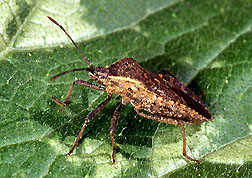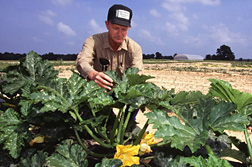Reviving Trap Cropping
Melon growers’ next battle cry against insect pests could be Squash ’em!
Once warmed by spring’s arrival, cucumber beetles and squash bugs are soon on the move. They are looking to feast on the tender seedlings of watermelon or other cucurbits, like cantaloupe. This can put melon growers on the defensive, forcing them to blanket their crop fields with insecticide.
But some growers in central Texas and southcentral Oklahoma are taking a different tack. Rather than resort to broadcast spraying, they’re “squashing” their beetle and bug foes instead.
Yes, squashing them—and also saving on insecticides and beneficial insects like the lacewing. But growers don’t use their boot heels to do the job. Instead, they follow the direction of ARS entomologist Sam D. Pair.
His advice: Line the edge of the melon field with a few rows of squash—the beetles’ and the bugs’ cucurbit crop of choice.
This integrated approach to pest management does three things, says Pair, who is at ARS’ South Central Agricultural Research Laboratory in Lane, Oklahoma.
It lures hungry insects away from melon seedlings, leaving them to grow, unmolested, into fruit-bearing plants. It encourages the insects to congregate on squash plants, where a judicial application of insecticide can kill them. And it eliminates the need to spray the entire field.
“If we can concentrate insect pests early in the season in a preferred host crop and control them there,” Pair explains, “then we can also reduce the late-season buildup of insect offspring in the primary crop at its fruiting stage.”
This tactic is called trap cropping. Its strength lies in a key weakness of the insect pests: an inherent preference for squash over watermelon or cantaloupe. What, precisely, attracts the insects to squash isn’t known. Scientists have yet to pin down whether it’s the scent of the plant, its size or color, nutritional content, or possibly a combination of all these traits.
Whatever the attraction, Pair has sought to make it fatal.
In field studies with melon, the squash lured more than 66 percent of cucumber beetles and 90 percent of squash bugs. A single application of either a systemic or foliar insecticide spelled doom for those drawn to the treated squash plants.
 Squash bug. (K7763-1) |
“Normally the squash attracts enough of the population that what’s left in the melon crop is not a problem,” Pair notes.
Bob Whitney, a Texas A&M University extension agent in Comanche County, Texas, reports excellent results from five producers who used the approach last year against cucumber beetles.
The 1/4-inch-long pest jeopardizes some 10,000 to 12,000 acres of melons grown in Comanche, located about 200 miles north of San Antonio. Whitney says that depending on the type of insecticide, melon growers can spend $10 to $40 per acre on active ingredient, with about a $4 application fee attached. The cost of spraying a 100-acre field just once, for example, could range between $1,400 and $4,400.
During the course of the growing season, melon producers may resort to insecticide as many as three or four times, or whenever scouting detects one beetle for every four or five plants. But with squash as a beetle decoy, “there’s no need to have an insecticide in the melon crop at all,” Whitney says. May and June are the months the beetle is most troublesome. “That’s when we plant a lot of melons,” says Whitney, who suggests transplanting squash 3 to 7 days before melon.
Left-unchecked, cucumber beetles can wipe out an entire seedling stand.
In Comanche County, the squash bug is less of a problem. But its mischief can’t be ignored either, particularly since it breeds prolifically. The 3/4-inch-long bug sucks juices from both seedlings and fruit-bearing plants. It can also compound plant stress, such as that caused by drought.
Often, a systemic insecticide is called on. “But we don’t like to use those,” says Whitney. “The few that we have that are good for cucumber beetles and squash bugs are harsh and require special precautions so growers can use them.”
That's also a concern of producer Mark Weatherly, who grows 350 total acres of melon in Love County, Oklahoma. He's in his second season of using squash trap crops.
Unlike Comanche County growers, his chief concern is the squash bug. Because his field is subject to wind-driven assaults, Weatherly plans to bolster his squash defenses with additional rows. "I'd like to plant some rows in the middle of the field," he says.
Last year, wind-blown bugs landing in the melon crop, coupled with a lack of adequate squash rows, forced Weatherly to spray one of his fields. Armed with his new squash defense, "I'm going to try it again and see," he says.
Great for Beneficials
Besides cutting back on acreage that requires chemical protection, a squash trap crop can offer another benefit: grant predatory insects like lacewings a new lease on life. Minus insecticide, they can prowl crop fields for secondary pests like aphids, which can flourish in the absence of bug or beetle competitors.
 Entomologist Sam Pair inspects squash plants for cucumber beetles and squash bugs lured to this trap crop and away from developing melons. (K7764-1) |
"When the fields are without insecticides, lacewings and ladybugs just go crazy," Whitney says. "This has helped keep our aphids in check."
Pair and plant pathologist Benny D. Bruton see another benefit: protecting melons from cucumber beetles that harbor Erwinia tracheiphila, the organism that causes bacterial wilt.
"If you can reduce the number of beetles carrying this bacterium," says Pair, "you should be able to reduce the incidence of the disease in the main crop."
This would probably benefit growers of the Midwest or mid-Atlantic states like Maryland, he says, where the wilt generally poses more of a melon threat than in the Southern Plains.
Other than curbing beetle-borne disease, “We’re looking at using trap cropping as a management strategy against the insect vector of yellow vine decline,” Pair says.
He and Bruton are investigating whether squash can attract the mystery insect that spreads this disease before it finds its way into the melon crop. One suspect is the leaf hopper, which can pass along disease-causing microbes as it probes plant tissues to feed.
Whatever the culprit, what worries growers like Rodney Stephens of Comanche County is that yellow vine decline "can take out the whole field overnight."
Over the past 4 years, Stephens' crops have remained unscathed, but he's still uncertain whether to credit the squash around his fields. "We haven't seen it when using squash for trap cropping, but we also haven't seen [the disease] without it," says Stephens, who grows 50 to 100 acres of melon each season.
Stephens plans to continue his squash trap crops. "One of the things I like is a little different source of income with squash," he says. And "if it helps keep insects out of my melons, then I'm getting a double benefit."
Key to this is selecting a high-yielding squash variety and keeping it well-watered and fertilized. Scouting for insect activity is also important to prevent migration into the melon field.
Pair hopes to capitalize on squash’s success further with other tactics. One is using colored plastic mulch, either as a repellent or added attractant to further tempt beetles or bugs into being “squashed.” — By Jan Suszkiw, ARS.
Sam D. Pair and Benny D. Bruton are at the USDA-ARS South Central Agricultural Research Laboratory, P.O. Box 159A, Lane, OK 74555.







